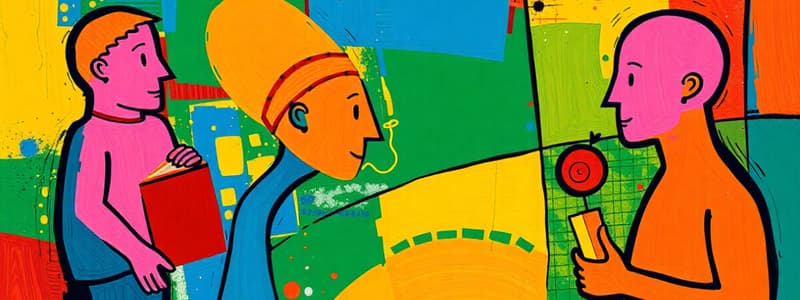Podcast
Questions and Answers
What is the primary focus of microeconomics?
What is the primary focus of microeconomics?
- Analyzes the behavior of individual economic units (correct)
- Examines global trade patterns
- Focuses solely on government policies
- Studies groups and economies as a whole
Which of the following best describes scarcity in economics?
Which of the following best describes scarcity in economics?
- A situation where all goods are in surplus
- Limited resources relative to unlimited wants (correct)
- An economic system with no constraints
- The abundance of resources available
What does the opportunity cost represent?
What does the opportunity cost represent?
- The highest possible return on investment
- The benefit of the best alternative foregone (correct)
- Total profit gained from a decision
- The immediate costs incurred from a decision
How does the law of demand relate price to quantity demanded?
How does the law of demand relate price to quantity demanded?
What is represented by a budget line in consumer behavior theory?
What is represented by a budget line in consumer behavior theory?
What does the term 'marginal utility' refer to?
What does the term 'marginal utility' refer to?
What does the law of diminishing marginal utility state?
What does the law of diminishing marginal utility state?
What is the definition of consumer equilibrium?
What is the definition of consumer equilibrium?
What is the main factor that causes the marginal product to eventually become negative according to the Law of Variable Proportions?
What is the main factor that causes the marginal product to eventually become negative according to the Law of Variable Proportions?
Which of the following correctly defines Total Cost (TC)?
Which of the following correctly defines Total Cost (TC)?
What signifies Producer's Equilibrium in a perfectly competitive market?
What signifies Producer's Equilibrium in a perfectly competitive market?
Which of the following is a characteristic of Perfect Competition?
Which of the following is a characteristic of Perfect Competition?
What is the effect of a Price Ceiling in a market?
What is the effect of a Price Ceiling in a market?
How is Average Revenue (AR) calculated?
How is Average Revenue (AR) calculated?
What happens during a situation of Excess Supply?
What happens during a situation of Excess Supply?
Which type of cost can vary directly with the level of output produced?
Which type of cost can vary directly with the level of output produced?
Flashcards
Microeconomics
Microeconomics
The study of how individual economic units, like households and businesses, make choices about using limited resources.
Macroeconomics
Macroeconomics
The study of the economy as a whole, including things like national income and inflation.
Economy
Economy
A system that organizes how goods and services are produced, distributed, and used in a society.
Scarcity
Scarcity
Signup and view all the flashcards
Opportunity Cost
Opportunity Cost
Signup and view all the flashcards
Utility
Utility
Signup and view all the flashcards
Marginal Utility
Marginal Utility
Signup and view all the flashcards
Law of Diminishing Marginal Utility
Law of Diminishing Marginal Utility
Signup and view all the flashcards
Production Function
Production Function
Signup and view all the flashcards
Law of Variable Proportions
Law of Variable Proportions
Signup and view all the flashcards
Fixed Cost
Fixed Cost
Signup and view all the flashcards
Variable Cost
Variable Cost
Signup and view all the flashcards
Total Cost
Total Cost
Signup and view all the flashcards
Marginal Cost
Marginal Cost
Signup and view all the flashcards
Average Cost
Average Cost
Signup and view all the flashcards
Producer's Equilibrium
Producer's Equilibrium
Signup and view all the flashcards
Study Notes
Microeconomics Overview
- Microeconomics studies individual economic units (households, firms, industries). It analyzes how these units make decisions about allocating limited resources.
- Macroeconomics studies the economy as a whole. It examines national income, inflation, unemployment, and economic growth.
- Economy is the system organizing the production, distribution, and consumption of goods and services.
- Scarcity exists because resources are limited, while human wants are unlimited.
- Opportunity Cost is the value of the next best alternative forgone when a choice is made.
- Central Economic Problems arise from scarcity: deciding what to produce, how to produce, and for whom to produce.
Consumer Behavior
- Utility is the satisfaction or pleasure derived from consuming a good or service.
- Total Utility (TU) is the total satisfaction obtained from consuming a given quantity of a good.
- Marginal Utility (MU) is the additional satisfaction gained by consuming one more unit of a good.
- Law of Diminishing Marginal Utility states that as more units of a good are consumed, marginal utility decreases.
- Budget Line shows all possible combinations of goods a consumer can purchase with their income at prevailing prices.
- Consumer Equilibrium occurs when a consumer maximizes satisfaction given their income and prices.
Production and Costs
- Production Function shows the maximum output achievable with given inputs.
- Law of Variable Proportions describes how the marginal product of a variable input changes as it increases, first increasing, then decreasing, and finally becoming negative while a fixed input remains constant.
- Fixed Costs do not change with the level of output.
- Variable Costs change with the level of output.
- Total Cost (TC) is the sum of fixed and variable costs at a given level of output.
- Marginal Cost (MC) is the additional cost of producing one more unit of output.
- Average Cost (AC) is the cost per unit of output (Total Cost divided by the quantity of output).
Perfect Competition
- Market is a place where buyers and sellers interact to exchange goods and services.
- Perfect Competition is a market structure with many buyers and sellers, homogeneous products, free entry/exit, and perfect knowledge.
- Revenue is the income earned by a firm.
- Total Revenue (TR) is the total income earned (Price multiplied by Quantity sold).
- Average Revenue (AR) is revenue per unit of output (TR divided by Quantity sold).
- Marginal Revenue (MR) is the additional revenue earned from selling one more unit of output.
- Producer's Equilibrium in perfect competition occurs when Marginal Revenue equals Marginal Cost.
Market Equilibrium
- Market Equilibrium occurs when quantity demanded equals quantity supplied at a given price.
- Excess Demand occurs when quantity demanded exceeds quantity supplied.
- Excess Supply occurs when quantity supplied exceeds quantity demanded.
- Price Ceiling is a government-imposed maximum price.
- Price Floor is a government-imposed minimum price.
Non-Competitive Markets
- Monopoly is a market structure with one seller controlling the entire market with no close substitutes.
- Monopolistic Competition involves many sellers offering differentiated products/services with some control over price.
- Oligopoly is a market structure with a few large firms dominating the market, often with significant entry barriers.
- Cartel is a group of firms colluding to control prices and limit competition.
Studying That Suits You
Use AI to generate personalized quizzes and flashcards to suit your learning preferences.




